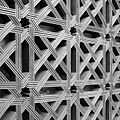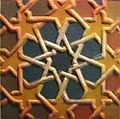Islamic interlace patterns

Geometric interlacing patterns are a subcategory of Islamic pattern and ornament. They can be considered a particular type of arabesque which developed from the rich interlace patterning of the Byzantine Empire, and Coptic art. One of the first Western studies of the subject was E. H. Hankin's "The Drawing of Geometric Patterns in Saracenic Art", published in Memoirs of the Archaeological Societry of India in 1925.[1]
....the intricate interlacings common in later medieval Islamic art, are already prefigured in Umayyad architecture revetments: in floor mosaics, window grilles, stone and stucco carvings and wall paintings(Khirbat al-Mafjar, Qusayr'Amra, Qasr al-Hayr al-Gharbi etc.), and in the decoration of a whole group of early east Iranian, eighth- to tenth-century metal objects.[2]
Examples of geometric interlacing can also be found in Arabic calligraphy, particularly designs made in the Square Kufic style.[3]
Owen Jones, in his catalog for the Crystal Palace exhibition, wrote about the decorative art found in Alhambra, where much of the art work consists of interwoven designs, that:
The grace and refinement of Greek ornament is here surpassed. Possessing, equally with the Greeks, an appreciation of pure form, the Moors exceeded them in variety and imagination.[4]
E. H. Hankin, in his book The Drawing of Geometric Patterns in Saracenic Art, takes the view that the artists who created these designs used a method based on the use of the compass and the straight edge.[5] This view is supported by the majority of contemporary authorities on the subject, such as Keith Critchlow in his book, Islamic Patterns: An Analytical and Cosmological Approach.[6] This explains how ornamented objects as varied in size as a book or a mosque, were treated by artists using the same geometric methods adopted to the size and nature of the object being ornamented.[7]
On the other hand Owen Jones, in The Grammar of Ornament, describes a method whereby this type of interlace ornament is, instead, designed based on a foundation of geometric grids, with the same foundational grids re-drawn to the size of the object.[8]
-
-
-

-

-

-

Basmala in kufic calligraphy
-

-

-

-

See also
- Benzene ring
- Endless knot
- Eternal return
- Girih
- Khachkars - Armenian knotwork
- Knots and graphs a mathematical way of describing Celtic knots.
- Knot garden
- Mandala
- Möbius strip
- Triquetra
- Turk's head knot
- Yin and yang
References
- ↑ "The Drawing of Geometric Patterns in Saracenic Art", "Preface"
- ↑ Eva Baer Islamic Ornament p.41. New York University Press, 1998 ISBN 0-8147-1329-7
- ↑ Sakkal, Mamoun. "How to design Square Designs in Square Kufi". Sakkal.com.
- ↑ Iain Zaczek quoting Owen Jones, in his annotation of Owen Jones' The Grammar of Ornament, p.206
- ↑ E. H Hankin, The Drawing of Geometric Patterns in Saracenic Art, p.2
- ↑ Keith Critchlow, Islamic Patterns: An Analytical and Cosmological Approach, p.9
- ↑ Daud Sutton, Islamic Design: A Genius for Geometry, Walker Publishing Company, 2007. p. 1. (ISBN- 10: 0-8027-1635-0)
- ↑ Owen Jones, The Grammar of Ornament, p.72-73
Further reading
- Critchlow, Keith, Islamic Patterns : an analytical and cosmological approach, London : Thames and Hudson, 1976. ISBN 0500270716
External links
- Nomad Inception: An Islamic geometric design and floral arabesques consultancy
- Craig S. Kaplan Taprats a website devoted to Islamic design, with an applet to draw such star-like figures.

